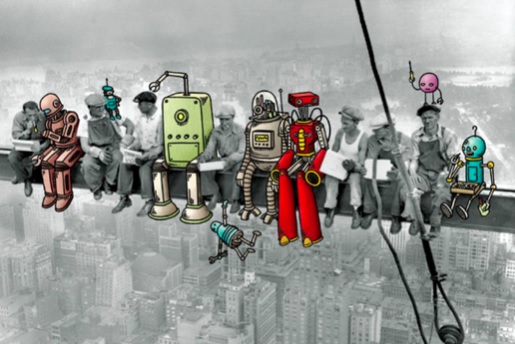The Future of Labor: The Automated Workplace Amid the Fourth Industrial Revolution
Champaign, IL - April 15, 2019
The link between technology and the workplace is evident by anyone who ventures to a factory floor or spends time in an office, and this influence is especially acute at certain points in the history of humankind - the industrial revolutions of the late eighteenth century, the late nineteenth century, and the mid twentieth century. Society has been propelled to the cusp of the fourth industrial revolution, spurred by technology that has advanced at an exponential rate, as observed by Moore's law which states: the number of transistors (building blocks of microchips) in an integrated circuit doubles every two years. Many in the tech sector believe Moore's law will be irrelevant in the next five years there, but current processing power still allows for advances in automation and a restructuring of the workplace. The Fourth Industrial Revolution will introduce forms of "cyber-physical systems" that will display new functions for both humans and machines - it will even involve the integration of technology into the human body itself in the form of genome editing and
biohacking
.
The Fourth Industrial Revolution is daunting, and "cyber-phsyical" systems will undoubtedly have an effect on the labor economy; however, it is important to remember that the shift towards automation and the integration of physical and digital systems is driven by the choices of people - consumers, investors and regulators. Furthermore, as witnessed in every industrial revolution, and throughout history in general, the loss of certain jobs often creates new jobs or alters tasks. The ATM was thought to make the position of bank teller obsolete in the 1980s, but the number of tellers actually increased over the decade as their tasks shifted from money handling to administrative roles and sales. Imagine asking your mother or father at the beginning of their career what jobs would exist in 2019. It is safe to assume their answer would not include website or app developers, social media managers, or driverless car engineers.

The driverless car engineer did not exist even a decade ago, but what are the implications of this newly created position? Take truck drivers as an example, who currently number roughly 3.5 million in the United states and earn an average annual salary of $71,732. If driverless semis become a reality in the near future then one can assume companies will make a one time investment on a driverless truck rather than paying a driver's salary for forty years. Safety concerns may lead to the regulation of driverless cars. Companies may remain leary of the liability around the new technology, but it is not unreasonable to conclude that as the technology improves drivers will be displaced. So what do the three and a half million workers do for work when their job is replaced by an operating system? Do men and women without a college degree shift to becoming driverless car engineers or software developers? A truck driver of thirty years will probably not go back to school and get a master's degree in computer science, but one can imagine a person of such a background pursuing a skills based training course that offers a clear path to employment.
Drivers are not the only group at risk of having their jobs taken by R2-D2. Office positions such as administrative assistants and positions of predictable physical labor (fine equipment installation, repair workers, dishwashers) are among the duties most likely to be automated in the United States. Some studies estimate that between 400-800 million jobs could be displaced by automation by 2030 but that 8-9% of labor demand will be for occupations that do not currently exist. These occupations will require higher levels of education and displaced workers will require additional training in order to contribute to the ever changing workplace. Positions that require social and emotional skills, creative problem solving, and communication will be among the most secure.
While some positions will remain in 2030 many occupations will become obsolete or require additional skills as AI develops. New education models will need to be introduced such as workplace training programs in order to maintain economic growth. Business will be on the front line of implementing changes by retooling business processes and talent strategies as well as preparing workers for the future of work. Finally, workers will need to carefully consider the new world of work, how they fit in the labor force and what they can contribute in the automated workplace.